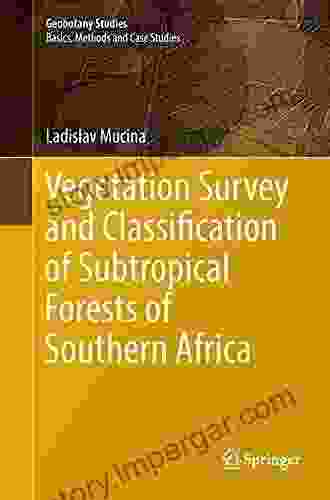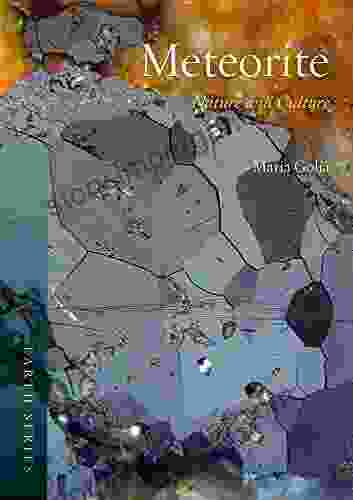Meteorite: Nature and Culture in Earth's History

4.8 out of 5
| Language | : | English |
| File size | : | 7174 KB |
| Text-to-Speech | : | Enabled |
| Screen Reader | : | Supported |
| Enhanced typesetting | : | Enabled |
| Word Wise | : | Enabled |
| Print length | : | 213 pages |
Meteorites are fragments of asteroids or comets that have fallen to Earth. They are a valuable source of information about the composition and history of the solar system. Meteorites can also provide clues about the origin of life on Earth and the role that extraterrestrial impacts have played in shaping our planet's history.
Meteorites come in a variety of sizes and shapes. Some are as small as a grain of sand, while others are as large as a car. Meteorites are classified into three main types: stony meteorites, iron meteorites, and stony-iron meteorites. Stony meteorites are the most common type, and they are composed primarily of silicate minerals. Iron meteorites are composed primarily of iron and nickel, and they are often found in large impact craters. Stony-iron meteorites are a mixture of stony and iron materials.
Meteorites have been falling to Earth for billions of years. The oldest known meteorite is a 4.5-billion-year-old stony meteorite that was found in Australia. Meteorites have played a significant role in Earth's history. They have delivered water and organic molecules to Earth, and they may have also helped to seed life on our planet. Meteorites have also been responsible for some of the most catastrophic events in Earth's history, including the extinction of the dinosaurs.
Meteorites are not only a source of scientific information. They are also a source of inspiration and wonder. Meteorites have been used in art and jewelry for centuries, and they have been featured in countless stories and legends. Meteorites are a reminder of our place in the universe and of the interconnectedness of all life on Earth.
The Nature of Meteorites
Meteorites are fragments of asteroids or comets that have fallen to Earth. They are typically composed of rock, metal, or a mixture of both. Meteorites can range in size from a few grams to several tons. The largest known meteorite is the Hoba meteorite, which weighs approximately 60 tons. Meteorites are classified into three main types: stony meteorites, iron meteorites, and stony-iron meteorites.
Stony meteorites are the most common type of meteorite. They are composed primarily of silicate minerals, such as olivine, pyroxene, and feldspar. Stony meteorites can be further classified into two subclasses: chondrites and achondrites. Chondrites are meteorites that contain small, rounded inclusions called chondrules. Achondrites are meteorites that do not contain chondrules.
Iron meteorites are composed primarily of iron and nickel. They are often found in large impact craters. Iron meteorites can be further classified into two subclasses: octahedrites and hexahedrites. Octahedrites are iron meteorites that have a crystalline structure that resembles the shape of an octahedron. Hexahedrites are iron meteorites that have a crystalline structure that resembles the shape of a hexahedron.
Stony-iron meteorites are a mixture of stony and iron materials. They are typically composed of approximately 50% rock and 50% metal. Stony-iron meteorites can be further classified into two subclasses: pallasites and mesosiderites. Pallasites are stony-iron meteorites that contain large, olivine crystals. Mesosiderites are stony-iron meteorites that contain a mixture of small, rounded inclusions called chondrules.
The Impact of Meteorites on Earth
Meteorites have played a significant role in Earth's history. They have delivered water and organic molecules to Earth, and they may have also helped to seed life on our planet. Meteorites have also been responsible for some of the most catastrophic events in Earth's history, including the extinction of the dinosaurs.
The impact of a meteorite can have a variety of effects on Earth. The impact of a small meteorite may simply create a small crater. The impact of a large meteorite can cause widespread damage and even trigger a global catastrophe. The impact of a meteorite can also release large amounts of dust and gas into the atmosphere, which can block out the sun and cause a global cooling event.
The most famous meteorite impact in Earth's history is the Chicxulub impact, which occurred approximately 66 million years ago. The Chicxulub impact is believed to have caused the extinction of the dinosaurs. The impact of the Chicxulub meteorite created a crater that is approximately 180 kilometers in diameter. The impact is also believed to have triggered a global cooling event that lasted for several years.
Meteorites in Human Culture
Meteorites have been used in art and jewelry for centuries. Meteorites have also been featured in countless stories and legends. Meteorites are a reminder of our place in the universe and of the interconnectedness of all life on Earth.
The oldest known meteorite artifact is a pendant that was found in Iraq. The pendant is made from a piece of iron meteorite and is decorated with a series of geometric patterns. The pendant is believed to be approximately 5,000 years old.
Meteorites have also been used in jewelry since ancient times. Meteorites are often used to make pendants, rings, and earrings. Meteorites are also used to make sculptures and other works of art.
Meteorites have been featured in countless stories and legends throughout history. In many cultures, meteorites are seen as a symbol of good luck or a sign from the gods. In some cultures, meteorites are believed to have healing powers.
Meteorites are a reminder of our place in the universe and of the interconnectedness of all life on Earth. Meteorites are a valuable source of information about the composition and history of the solar system. Meteorites can also provide clues about the origin of life on Earth and the role that extraterrestrial impacts have played in shaping our planet's history.
4.8 out of 5
| Language | : | English |
| File size | : | 7174 KB |
| Text-to-Speech | : | Enabled |
| Screen Reader | : | Supported |
| Enhanced typesetting | : | Enabled |
| Word Wise | : | Enabled |
| Print length | : | 213 pages |
Do you want to contribute by writing guest posts on this blog?
Please contact us and send us a resume of previous articles that you have written.
 Book
Book Novel
Novel Page
Page Chapter
Chapter Text
Text Story
Story Genre
Genre Reader
Reader Library
Library Paperback
Paperback E-book
E-book Magazine
Magazine Newspaper
Newspaper Paragraph
Paragraph Sentence
Sentence Bookmark
Bookmark Shelf
Shelf Glossary
Glossary Bibliography
Bibliography Foreword
Foreword Preface
Preface Synopsis
Synopsis Annotation
Annotation Footnote
Footnote Manuscript
Manuscript Scroll
Scroll Codex
Codex Tome
Tome Bestseller
Bestseller Classics
Classics Library card
Library card Narrative
Narrative Biography
Biography Autobiography
Autobiography Memoir
Memoir Reference
Reference Encyclopedia
Encyclopedia Marcus Reeves
Marcus Reeves Michael Block
Michael Block Martin Seidel
Martin Seidel Sandra M Gilbert
Sandra M Gilbert Nick Cato
Nick Cato Maryalayne B Long
Maryalayne B Long Matthias Surovcik
Matthias Surovcik Mark L Latash
Mark L Latash Mary Ashby Mcdonald
Mary Ashby Mcdonald Marion Omalley
Marion Omalley Marcus Deminco
Marcus Deminco Robin Prior
Robin Prior Mark Waller
Mark Waller Mobo Reader
Mobo Reader Monika Khatwani
Monika Khatwani World Number 2
World Number 2 Marcelo Gleiser
Marcelo Gleiser Hooshang Amirahmadi
Hooshang Amirahmadi Tony Messenger
Tony Messenger Willa Cather
Willa Cather
Light bulbAdvertise smarter! Our strategic ad space ensures maximum exposure. Reserve your spot today!

 Fernando PessoaSeaplanes That Flew From Ships Without Flight Decks: A Forgotten Chapter in...
Fernando PessoaSeaplanes That Flew From Ships Without Flight Decks: A Forgotten Chapter in...
 Gregory WoodsMaster the Core Medical Sciences for Clinical Success: Basic Sciences for...
Gregory WoodsMaster the Core Medical Sciences for Clinical Success: Basic Sciences for... Warren BellFollow ·17.6k
Warren BellFollow ·17.6k Caleb CarterFollow ·18.3k
Caleb CarterFollow ·18.3k Samuel Taylor ColeridgeFollow ·14.2k
Samuel Taylor ColeridgeFollow ·14.2k Bernard PowellFollow ·18.5k
Bernard PowellFollow ·18.5k Ike BellFollow ·10.6k
Ike BellFollow ·10.6k Jeff FosterFollow ·10.7k
Jeff FosterFollow ·10.7k Jeffery BellFollow ·19.7k
Jeffery BellFollow ·19.7k Camden MitchellFollow ·8.3k
Camden MitchellFollow ·8.3k

 Roberto Bolaño
Roberto BolañoUnveiling the Beauty and History of the Medici Iris: A...
In the realm of...

 Theodore Mitchell
Theodore MitchellImproving Gut Health in Poultry: Unlocking the Path to...
In the ever-evolving field of...

 Victor Hugo
Victor HugoPersonalized Medicine with a Nanochemistry Twist:...
The future of healthcare...

 George Martin
George MartinA Year Of Wine: Perfect Pairings Great Buys And What To...
## Year of Wine: An Epic Journey Through the...

 Tom Hayes
Tom HayesDelve into the Enigmatic World of Southern Africa's...
Embark on a captivating journey through the...
4.8 out of 5
| Language | : | English |
| File size | : | 7174 KB |
| Text-to-Speech | : | Enabled |
| Screen Reader | : | Supported |
| Enhanced typesetting | : | Enabled |
| Word Wise | : | Enabled |
| Print length | : | 213 pages |










